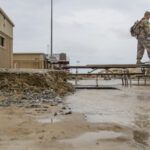Science teachers in the trenches of the climate wars
By Glenn Branch | March 13, 2017
With a US President who claimed that climate change is a hoax perpetrated by China, a Secretary of State from the fossil fuel industry, a Secretary of Energy who once proposed to abolish the department, a Secretary of the Interior who dismissed climate change as “not proven,” and a chief of the Environmental Protection Agency with a history of obsessively challenging its regulations in court, it is clear that climate science is going to be encountering stormy weather during the Trump administration.
Calls for opposition and resistance to the newly invigorated assault on climate science are common—and welcome. But amid the scramble to archive government data on climate change, debunk the latest series of fact-free presidential tweets, defend federal scientists against political censorship, argue for a realistic estimate of the social price of carbon, and rally across the country for a March for Science, it is important not to overlook the importance of defending the integrity of climate education.
Why? It’s simple. Effective action on climate change is necessarily going to be a long-term—multigenerational—project. Our children, and their children, and their children in turn, will all need to understand the scientific consensus on climate change in order to flourish in the warming world in which they will live. And the best way to ensure that they do so is to use the most extensive and rigorous system in our society for producing understanding: the public school classroom.
The limited federal role. By custom and by statute, curriculum and instruction in the United States are controlled by state governments and local school districts. The federal government’s influence is negligible, which is perhaps comforting in view of the present administration’s attitude toward climate change. Even so, there is reason for concern about the fate of the excellent supplementary materials about climate science, aimed at K–12 educators, prepared by a veritable alphabet of various federal agencies.
The best of these materials enable teachers to have their students engage directly with the evidence for climate change—temperature fluctuations, sea level changes, ice core measurements, and more—so they can appreciate the strength and the variety of the evidence underlying the scientific consensus on the reality of climate change and human involvement in it. For these materials to be removed, censored, or rewritten under the tutelage of climate change deniers would be a shame.
State attacks on science. What almost happened recently in Iowa, however, would have been even worse. A bill designated House File 480 would have required teachers in the state’s public schools to include “opposing points of view or beliefs” to accompany any instruction relating to a handful of topics, including global warming. Astonishingly, the bill did not require that those “points of view or beliefs” have any scientific credibility—only that they be opposed to whatever material is presented in the classroom.
Global warming and climate change are addressed in Iowa’s state science education standards, so the passage of House File 480 would have directly required the miseducation of Iowa’s students about climate change. Not quite so ambitious, similar bills introduced in Oklahoma, South Dakota, and Texas would only allow such miseducation, while a similar resolution introduced in Alabama would merely express the legislature’s approval of such miseducation.
House File 480, in effect, ignored the Hawkeye State’s science education standards, but another bill would have undermined them. Under House File 140, the Iowa State Board of Education would have been prohibited from adopting, approving, or requiring the implementation of Iowa’s science education standards by local school districts. The lead sponsor of the bill objected to the standards in part because, in the words of a local reporter, they “shine a negative light on human impacts on climate change.”
Although House File 140 died in committee, legislative attempts to undermine the treatment of climate change in state science standards have succeeded elsewhere in the country. Particularly egregious was a recent pair of votes, by the House Education Committee and the Senate Education Committee in Idaho, to delete five standards—precisely those addressing climate change and human impact on the environment—from a proposed new set of state science education standards for the Gem State.
Local attitudes matter. Beyond the legislatures of the 50 states, there are the more numerous arenas of the 15,000-odd local school districts, where formal policies that discourage teachers from presenting the scientific consensus on climate change—or actively encourage them to present climate change denial—are recurrently under consideration. Even in the absence of such policies, there are often informal practices that have the same effect.
Do the attitudes in the local school districts affect whether and how climate change is taught there? Only 4.4 percent of public middle and high school science teachers—less than one in 20—reported experiencing any local pressure not to teach about the human causes of global warming, according to a rigorous national survey conducted in 2014–2015 by the National Center for Science Education and researchers at Pennsylvania State University.
But analysis of data from the same survey found a significant correlation between local attitudes and instructional approaches. State by state, and county by county, where there was a lower degree of public acceptance of climate change, teachers were less likely to emphasize the scientific consensus on climate change and more likely to use instructional strategies that promote doubt and denial among their students—or to avoid the topic altogether. On climate, teachers appear to take their cues from their communities.
High stakes. Whether at the local, state, or federal level, it is crucial to oppose measures that would undermine the integrity of climate education, not only because of the harm they would do if enacted but also because of the signal they send when introduced. Teachers need to be reassured that, the posturing of climate-change-denying policymakers notwithstanding, there is robust local support for teaching the scientific consensus on the reality of climate change and human involvement in it.
A lot is at stake. In any given year, there are about 15 million students in America’s public high schools, of whom only about six million are likely to attend college. So for at least nine million young people per year, their best chance of attaining scientific literacy—and with it a grasp of the scientific consensus on climate change—is here and now. And their chance depends on the readiness, willingness, and ability of their teachers to teach climate change honestly, accurately, and confidently.
Together, we make the world safer.
The Bulletin elevates expert voices above the noise. But as an independent nonprofit organization, our operations depend on the support of readers like you. Help us continue to deliver quality journalism that holds leaders accountable. Your support of our work at any level is important. In return, we promise our coverage will be understandable, influential, vigilant, solution-oriented, and fair-minded. Together we can make a difference.
Topics: Climate Change, Opinion















